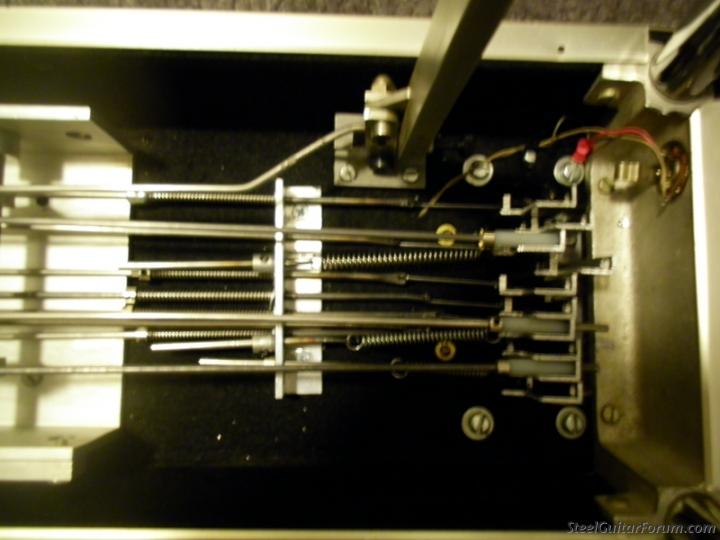| Author |
Topic: So I converted this MSA Sidekick to a Push/Pull |
Michael Hutchison
From:
Indianapolis, USA
|
 Posted 16 Nov 2011 7:09 pm
Posted 16 Nov 2011 7:09 pm |
|
The pictures should pretty much explain the "what". As to the "why" well, as you know a sidekick is a very basic pull-release. I knew I wanted to add some more knee levers, and be able to raise and lower the E's, and as I got to thinking about how I would have to go about tuning everything with multiples raises and / or lowers, I figured this would be the easiest way to get there. Ha! Was I wrong! The "How": Mind you, my "machine shop" consists of a $20 band saw and some harbor freight files. I cut the lower fingers out of 1/16" angle... I was a little bit worried about the neutral stop screws having enough meat to hold onto but it works just fine so far, keep you fingers crossed (pun intended). It may be borderline turd-polishing, but I don't have money for a modern guitar right now, and this actually works really well. Submitted for your enjoyment:
Here's the changer. Right now I have ABC pedals, E's raising and lowering on LKL/LKR, and 2nd to D on RKR (9th can of course lower too, but I don't have the rod in there right now.. got tired of tinkering and wanted to play!). I have space to add 2 more levers, but I'm not going to bother making them till I know what I want to use them for.
by the way, here's what they look like stock: http://bb.steelguitarforum.com/viewtopic.php?t=192426&sid=3a2bd910a9839a3fe13d0e0fdd308ada

Here you see that I was fortunate enough to aquire a sidekick that already had a 2nd undercarriage bracket added by some previous owner. Can you guess which knee lever is home-made?

The only pull that is tuned under the guitar; 4th string to F. I made this out of a brass radiator drain plug. 4 bucks and 3 minutes work. Easiest part of the whole project.

I originally had a design for a lower finger that had a ball on the end of a set screw that would move vertically, adjusted under the guitar, so I wouldn't have to cut a hole in the end of the body. This seemed easier. There's some exposed wood I'm not happy with but maybe that's being a bit picky in the grand scheme of things.

Here is how the changer works. It's the reverse of an Emmons in that the raises happen closest to the strings, and the lowers happen closest to your feet. The length of the fingers and the direction of the pedal cross shaft rotation dictated this.
Incidentally, for those who have never seen one, the red piece and the gray piece with the screw through it are the original sidekick pull/release changer.

_________________
- Mike |
|
|
 |
Brendan Mitchell
From:
Melbourne Australia
|
 Posted 16 Nov 2011 9:51 pm
Posted 16 Nov 2011 9:51 pm |
|
Nessescity is the mother of invention !
Great job Mike , I love it .
Don't worry about that bit of bare wood , a touch of black paint and it will disapear . |
|
|
 |
chris ivey
From:
california (deceased)
|
 Posted 18 Nov 2011 11:20 am
Posted 18 Nov 2011 11:20 am |
|
| really cool...that's the kind of thinking i like! |
|
|
 |
Tony Dingus
From:
Kingsport, Tennessee, USA
|
 Posted 19 Nov 2011 7:19 pm
Posted 19 Nov 2011 7:19 pm |
|
How much of a tone change were there ? Good job.
Tony |
|
|
 |
Michael Hutchison
From:
Indianapolis, USA
|
 Posted 19 Nov 2011 8:26 pm
Posted 19 Nov 2011 8:26 pm |
|
Well, it still sounds terrible! I'm lucky if I can get one right note out of it. 
Kidding aside, I'd be blowing smoke if I claimed a huge improvement in tone. I like to think there was, but it took me 3 weeks to rebuild it, so it's just as likely that I forgot what it sounded like before. Unplugged, it does have that kindof sizzling sound that I've heard people talk about in Emmons's. So, I guess the answer is maybe.
However, the tuning IS better, thanks I guess to the positive stops in the changer. Not 'tone' per se, but it does make it sound better.
Thanks!
_________________
- Mike |
|
|
 |




